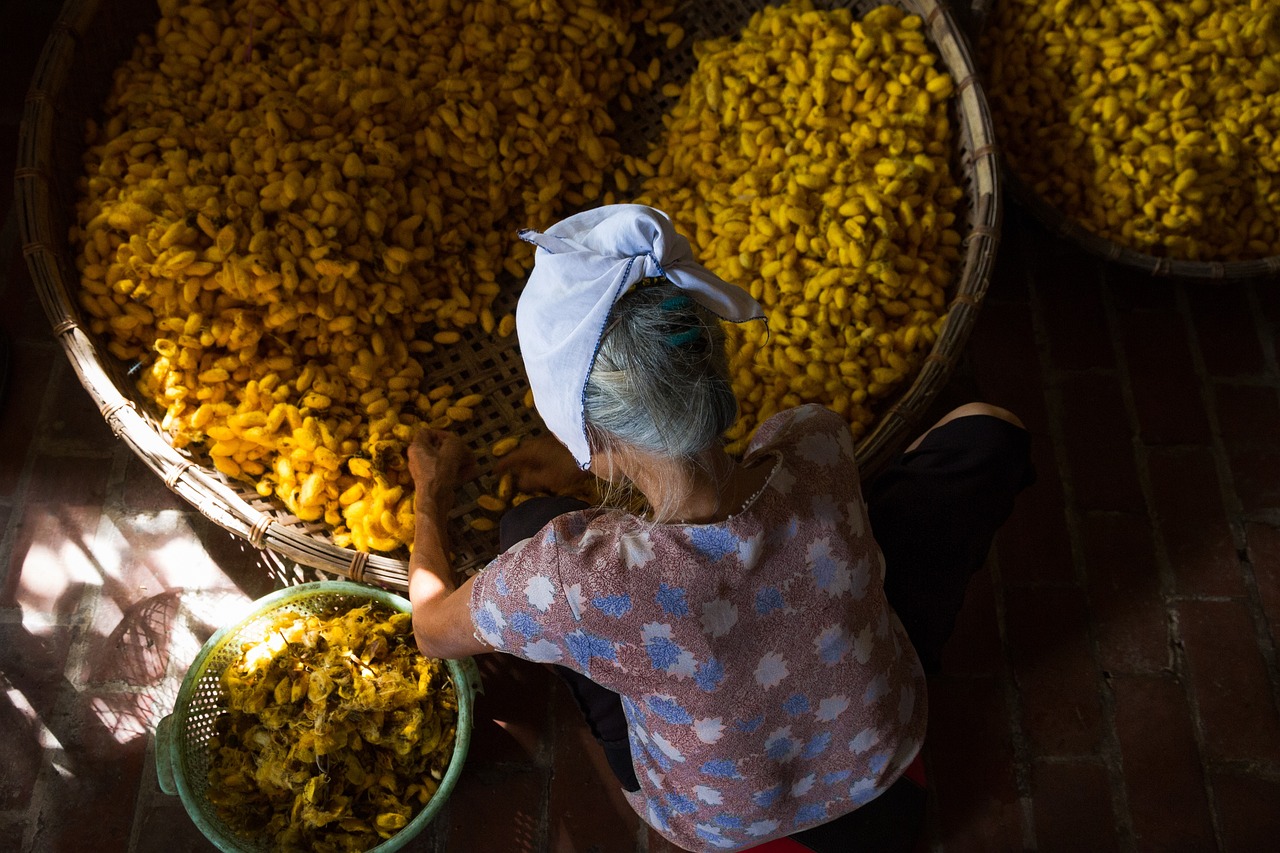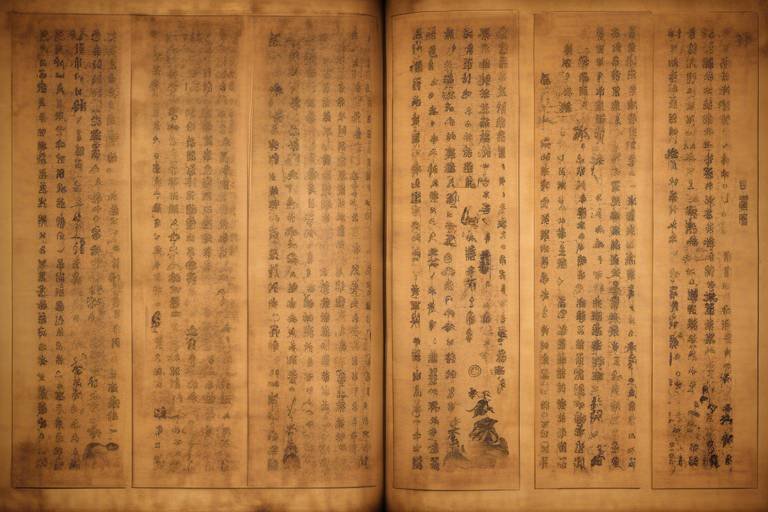The Secrets of the Ancient Silk Road Trade
Embark on a journey through time and space as we unravel the enigmatic secrets of the ancient Silk Road trade, a legendary route that bridged the gap between the East and the West, fostering a vibrant exchange of goods, ideas, and cultures.
The origins of the Silk Road trace back to the Han Dynasty in China, where the demand for silk spurred the creation of a vast network of trade routes spanning from China to the Mediterranean. Over centuries, this network expanded, linking regions as distant as Rome and Chang'an, the ancient capital of China.
Picture the bustling markets filled with an array of trade goods - shimmering silk fabrics, aromatic spices, gleaming precious metals - all traversing treacherous terrains and perilous deserts on their way to distant lands. Merchants braved the unknown, seeking fortune and adventure along the intricate web of Silk Road routes.
Amidst the exchange of goods, a profound cultural exchange took place along the Silk Road. Ideas, religions, and technologies flowed freely, shaping the identities of civilizations on both ends of the trade route. The Silk Road became a melting pot of diversity, a meeting point of East and West.
Yet, the Silk Road was not without its challenges. Traders faced harsh climates, marauding bandits, and shifting political landscapes, navigating a precarious path to secure their precious cargo. The tales of their resilience and ingenuity echo through the annals of history.
Central to the Silk Road's allure was the legend of silk, a luxurious fabric coveted by emperors and merchants alike. The secrets of silk production were closely guarded, shrouded in mystery and myth, adding an air of intrigue to this prized commodity that captivated the world.
As the tides of history shifted, the Silk Road gradually faded into obscurity, overshadowed by the rise of maritime trade routes. Yet, its legacy endures, as archaeological discoveries unveil the remnants of ancient caravanserais and trading posts, offering glimpses into a bygone era of commerce and cultural exchange.
In the modern age, efforts to revive the Silk Road as a symbol of economic cooperation and cultural diplomacy are underway. The allure of Silk Road tourism beckons travelers to retrace the footsteps of ancient merchants, breathing new life into once-forgotten heritage sites and communities.

Origins and Development
Exploring the historical significance and mysteries surrounding the ancient Silk Road trade route that connected East and West, facilitating cultural exchange and commerce between diverse civilizations.
The origins of the Silk Road can be traced back to the Han Dynasty in China, around 130 BCE, when the Chinese Emperor Wu Di dispatched envoys westward to establish trade relations with Central Asian kingdoms. This marked the beginning of a network of trade routes that would eventually span over 4,000 miles, linking China with the Mediterranean world. As the demand for luxury goods such as silk, spices, and precious metals grew, so did the need for safe and efficient trade routes, leading to the gradual expansion and development of the Silk Road.
Key players in the development of the Silk Road included not only merchants and traders but also diplomats, explorers, and scholars who played vital roles in bridging the cultural and geographical gaps between East and West. The Silk Road became a melting pot of diverse cultures, languages, and traditions, with each civilization contributing to the flourishing exchange of goods and ideas along the ancient trade route.
As the Silk Road evolved over centuries, new routes emerged, branching out to different regions and connecting distant civilizations. The development of the Silk Road was not only a testament to human ingenuity and perseverance but also a reflection of the interconnectedness of the ancient world, where trade served as a catalyst for cultural diffusion and mutual understanding.

Trade Goods and Routes
The ancient Silk Road was not just a pathway for the exchange of silk, but a bustling thoroughfare where a myriad of goods traversed between the East and the West. Merchants embarked on perilous journeys, braving treacherous terrains and unpredictable weather to transport their valuable cargo. Along the Silk Road, a rich tapestry of trade goods emerged, ranging from luxurious silk to exotic spices and precious metals.
Silk, the namesake of the famed trade route, held a special place in the hearts of traders and consumers alike. Its shimmering allure captivated the imaginations of those in distant lands, fueling a demand that transcended borders. The intricate process of silk production, shrouded in secrecy, added an air of mystique to this prized commodity, elevating its value and prestige among ancient civilizations.
Spices, with their intoxicating aromas and tantalizing flavors, also played a pivotal role in the Silk Road trade. Cinnamon, pepper, and cloves were among the exotic spices that tantalized the taste buds of traders and nobility alike, their origins shrouded in mystery and intrigue. These precious commodities not only added flavor to culinary delights but also served as symbols of wealth and status.
Precious metals, such as gold and silver, were highly sought after along the Silk Road for their intrinsic value and universal appeal. These shimmering treasures traversed vast distances, changing hands multiple times before reaching their final destinations. The allure of these precious metals transcended cultural boundaries, serving as a universal medium of exchange and a symbol of prosperity.
The routes taken by merchants along the Silk Road were as diverse as the goods they carried. From the bustling markets of Xi'an in China to the ancient city of Palmyra in Syria, a network of interconnected trade routes crisscrossed the vast expanse of Asia and Europe. Traders navigated deserts, mountains, and rivers, forging alliances and overcoming obstacles to ensure the safe passage of their valuable cargo.

Cultural Exchange
The along the ancient Silk Road was a vibrant tapestry of ideas, beliefs, and innovations intertwining across vast distances. Imagine traders from the East encountering merchants from the West, each carrying not only goods but also a wealth of cultural treasures waiting to be shared. This exchange was not just about silk and spices; it was about the exchange of knowledge, art, and philosophies that transcended borders and enriched civilizations.
As caravans traversed deserts and mountains, they carried more than just merchandise; they carried the essence of their respective cultures. Buddhist monks sharing teachings with Greek scholars, Chinese artisans trading techniques with Persian craftsmen – these interactions shaped the diverse landscape of the Silk Road, creating a melting pot of traditions and customs unlike anywhere else in the world.
One can almost picture the bustling marketplaces where traders haggled over prices in multiple languages, where aromas of exotic spices mingled with the sound of prayers from different faiths. The Silk Road was not just a trade route; it was a meeting point of civilizations, a crossroads of ideas that sparked innovation and creativity.
Through this cultural exchange, the Silk Road became a conduit for the spread of religions such as Buddhism, Islam, and Christianity, transcending geographical boundaries to unite people through shared beliefs. It was a place where art, architecture, and literature merged, giving rise to new forms of expression that blended the best of East and West.
While the goods traded along the Silk Road were valuable, it was the intangible treasures of knowledge and understanding that truly enriched the civilizations connected by this ancient network. The legacy of this cultural exchange continues to resonate in the modern world, reminding us of the power of connection and the beauty of diversity.

Challenges and Perils
Exploring the historical significance and mysteries surrounding the ancient Silk Road trade route that connected East and West, facilitating cultural exchange and commerce between diverse civilizations.
Understanding the inception of the Silk Road, its expansion over time, and the key players involved in shaping this vital trade route that spanned thousands of miles.
Delving into the variety of goods traded along the Silk Road, including silk, spices, and precious metals, and examining the different routes taken by merchants to reach their destinations.
Exploring how the Silk Road served as a conduit for the exchange of ideas, religions, and technologies between the East and the West, fostering a rich tapestry of cultural diversity.
Embarking on the Silk Road was not for the faint-hearted; traders faced a myriad of challenges and perils along the treacherous route. The unforgiving terrain, ranging from scorching deserts to towering mountain passes, tested the endurance of even the most seasoned travelers. Bandits lurked in the shadows, ready to pounce on unsuspecting caravans, adding an element of danger to every journey. Moreover, political instability in certain regions posed a constant threat to the safety of merchants and their valuable cargo. Despite these obstacles, the allure of the exotic goods and lucrative trade opportunities kept daring individuals venturing forth, navigating through the dangers with skill and determination.
Uncovering the significance of silk as a coveted commodity along the Silk Road, its impact on global trade, and the legends and myths surrounding its production and trade secrets.
Examining the factors that led to the eventual decline of the Silk Road, including the rise of maritime trade routes, and assessing the lasting legacy of this ancient trade network on the modern world.
Highlighting significant archaeological finds along the Silk Road that have provided insights into the daily lives of ancient traders and the cultural interactions that took place.
Exploring efforts to revive the Silk Road as a modern economic and cultural corridor, as well as the growing interest in Silk Road tourism and its impact on local communities and heritage sites.
If you have any questions about the ancient Silk Road trade, its history, significance, or impact, check out the following FAQs:
- What were the main goods traded along the Silk Road?
- How did the Silk Road influence cultural exchange between East and West?
- What led to the decline of the Silk Road as a major trade route?
- What are some notable archaeological discoveries along the Silk Road?

Role of Silk
Silk, often referred to as the "Queen of Fabrics," played a pivotal role in the ancient Silk Road trade, shaping the course of history and influencing global commerce. The allure of silk extended far beyond its luxurious texture and vibrant colors; it held a mystical quality that captivated the imaginations of people across continents. The production of silk was a closely guarded secret in ancient China, with the penalty for disclosing the process being death. This air of mystery only heightened the demand for silk along the Silk Road, turning it into a symbol of wealth, status, and power.
Merchants traversed treacherous terrains and braved harsh conditions to transport this precious fabric from the heart of China to the distant lands of the Mediterranean, where it commanded exorbitant prices. Silk became a currency of its own, facilitating trade and diplomatic relations between empires. The Silk Road owes much of its fame and prosperity to the silk trade, as it not only fueled economic growth but also fostered cultural exchanges that shaped the development of civilizations.
Aside from its economic significance, silk also played a symbolic role in bridging the gap between East and West, weaving together diverse cultures and traditions. The intricate patterns and designs of silk fabrics reflected the artistic sensibilities of different regions, blending influences from China, Persia, India, and beyond. Silk garments became prized possessions, worn by royalty and nobility as a testament to their refined taste and cosmopolitan connections.
Moreover, the production of silk involved intricate craftsmanship and meticulous attention to detail, embodying the ingenuity and skill of ancient artisans. The Silk Road not only facilitated the trade of silk but also served as a conduit for the exchange of knowledge and techniques related to sericulture and weaving. This transfer of expertise enriched local industries along the route, leading to the development of silk centers in cities like Samarkand, Bukhara, and Constantinople.

Decline and Legacy
As we delve into the decline and legacy of the ancient Silk Road, we uncover a tale of transition and transformation that shaped the course of global trade. The once bustling network of trade routes that connected the East and the West faced a gradual decline, giving way to new maritime routes that offered faster and more efficient trade options.
One of the key factors contributing to the decline of the Silk Road was the shift in trade patterns towards sea routes, which provided a more direct and cost-effective means of transportation. The rise of maritime trade routes, such as those utilized by European explorers like Vasco da Gama, gradually eclipsed the overland Silk Road in terms of efficiency and accessibility.
Despite its decline as a primary trade route, the legacy of the Silk Road continues to resonate in the modern world. The cultural exchanges, technological innovations, and economic ties forged along the Silk Road have left a lasting impact on global commerce and diplomacy.
Archaeological discoveries along the Silk Road have provided valuable insights into the daily lives of ancient traders and the intricate web of interactions that characterized this vibrant trade network. From ancient settlements to well-preserved artifacts, these discoveries offer a glimpse into the rich tapestry of cultures that once thrived along the Silk Road.
Efforts to revive the Silk Road as a modern economic and cultural corridor reflect a renewed interest in the legacy of this historic trade route. Initiatives aimed at promoting Silk Road tourism seek to showcase the diverse heritage and traditions of the regions that once flourished along the ancient trade routes, breathing new life into historical sites and local communities.

Archaeological Discoveries
Archaeological discoveries along the ancient Silk Road have unveiled a treasure trove of insights into the vibrant history of this legendary trade route. Excavations at various sites have unearthed a plethora of artifacts, ranging from intricately designed pottery to ancient coins and manuscripts. These findings provide a glimpse into the daily lives of traders and the cultural exchanges that took place along the Silk Road.
One of the most remarkable discoveries is the Mogao Caves in Dunhuang, China, which house a vast collection of Buddhist art spanning over a thousand years. The exquisite murals and sculptures found within these caves offer a glimpse into the religious beliefs and artistic expressions of the diverse communities that traversed the Silk Road.
Furthermore, the city of Palmyra in present-day Syria has yielded significant archaeological finds, showcasing the blend of Roman, Persian, and Arabian influences along the Silk Road. The ancient ruins of Palmyra stand as a testament to the thriving trade and cultural fusion that characterized this historic trade network.
In Uzbekistan, the city of Samarkand boasts the grandeur of Registan Square, adorned with majestic madrasas and mosques that reflect the architectural splendor of the Silk Road era. Excavations in Samarkand have revealed a wealth of artifacts, shedding light on the city's pivotal role as a hub of commerce and cultural exchange.
Moreover, the discovery of the Terracotta Army in Xi'an, China, stands as a testament to the grandeur of the ancient Silk Road. The life-sized terracotta soldiers, crafted to accompany Emperor Qin Shi Huang in the afterlife, exemplify the artistic prowess and technological advancements of the time, highlighting the intricate connections forged through trade and diplomacy along the Silk Road.

Revival and Tourism
As we delve into the modern era, efforts to revive the ancient Silk Road as a vibrant economic and cultural corridor are gaining momentum. Countries along the historic route are coming together to promote trade and cultural exchange, breathing new life into this once-thriving network of commerce. The revival of the Silk Road not only stimulates economic growth but also fosters diplomatic relations and strengthens ties between nations.
One of the most intriguing aspects of the Silk Road's revival is the emergence of Silk Road tourism. Travelers from around the globe are now embarking on journeys that trace the footsteps of ancient merchants, immersing themselves in the rich tapestry of cultures that flourished along the route. This surge in tourism has led to the restoration and preservation of historic sites and monuments, ensuring that the legacy of the Silk Road endures for future generations to explore and appreciate.
Local communities along the Silk Road are also reaping the benefits of increased tourism, with a growing number of visitors contributing to the local economy through the purchase of goods and services. This influx of tourism has led to the development of infrastructure and amenities to accommodate travelers, creating new opportunities for sustainable growth and cultural exchange.
Frequently Asked Questions
- What is the Silk Road?
The Silk Road was an ancient network of trade routes that connected the East and West, facilitating the exchange of goods, ideas, and cultures between diverse civilizations.
- When did the Silk Road originate?
The Silk Road is believed to have originated during the Han Dynasty in China around 206 BCE, and it continued to flourish for centuries, evolving and expanding over time.
- What were the main trade goods on the Silk Road?
Main trade goods on the Silk Road included silk, spices, precious metals, ceramics, textiles, and exotic fruits, which were highly sought after in different regions.
- How did the Silk Road contribute to cultural exchange?
The Silk Road played a crucial role in facilitating the exchange of ideas, religions, technologies, and artistic styles between the East and the West, leading to a rich cultural interchange.
- What led to the decline of the Silk Road?
The decline of the Silk Road was influenced by factors such as the rise of maritime trade routes, political instability, the spread of diseases, and the changing economic landscape.
- Are there efforts to revive the Silk Road today?
Yes, there are ongoing efforts to revive the Silk Road as a modern economic and cultural corridor, promoting trade, tourism, and cultural exchanges along its historical routes.



















